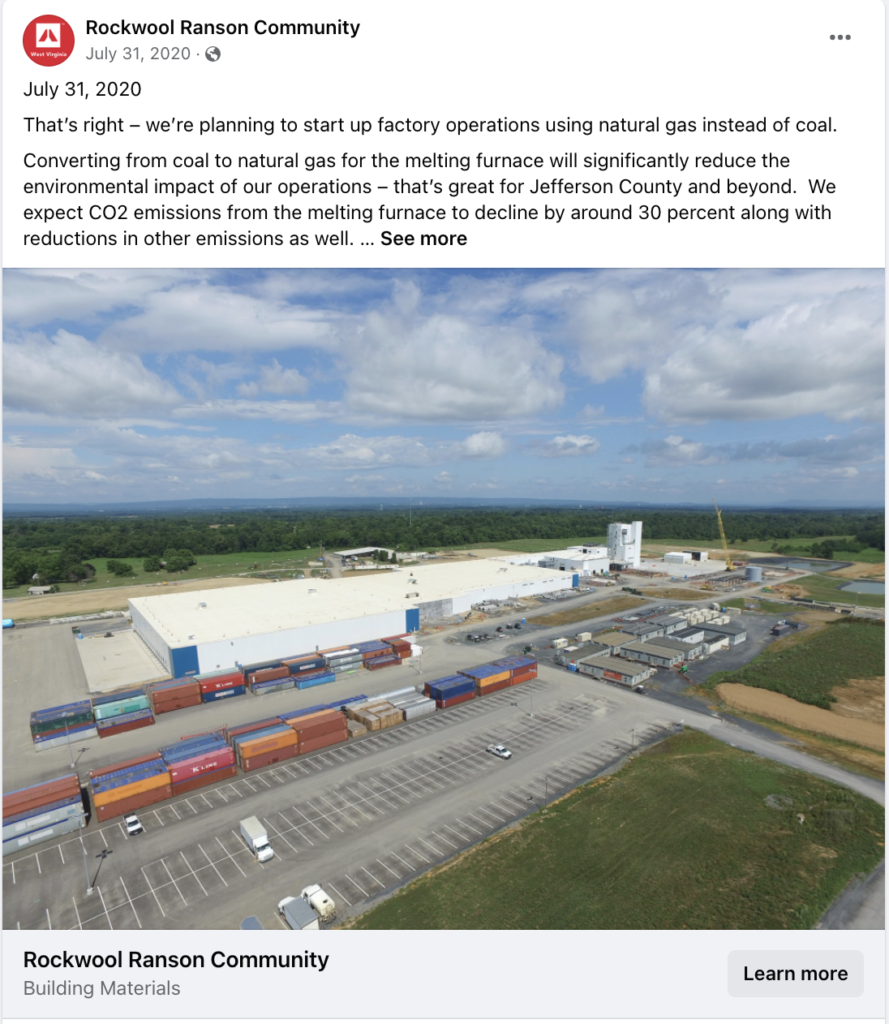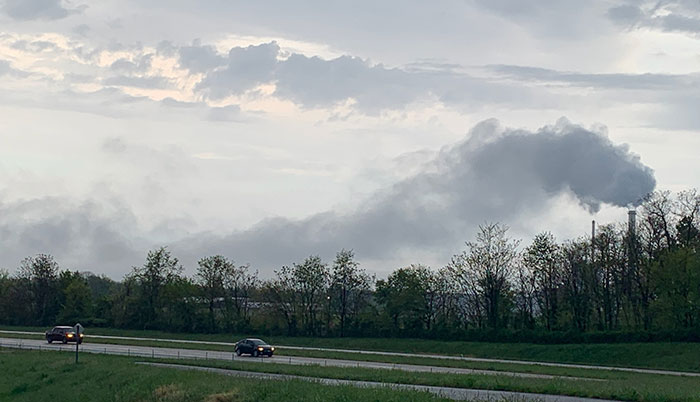Operational air permits for major air emission sources are required by Title V of the Clean Air Act. All major air emission sources such as Rockwool are required to apply for a Title V air permit within one year of starting operation. This permit is a legally-enforceable document designed to include pollution control requirements from federal or state regulations that apply to the source. In West Virginia, these are issued by the West Virginia Department of Environmental Protection (DEP) and reviewed by Region Three of the Environmental Protection Agency.
Quick Links
Construction Permit (PSD) vs. Operational permit (Title V)
The Prevention of Significant Deterioration (PSD) air permit to construct a major air emission source is obtained prior to construction of a new emission source. This process is meant to ensure that new emission sources will not cause significant deterioration of the air quality in a particular area and that each source is built with the appropriate control technology. The PSD permit uses background air monitor data and modeling to ensure the source’s planned emissions will not increase the concentration of any of the regulated air pollutants above the National Ambient Air Quality Standards (NAAQS) in the air in the area where the source is being constructed. The Best Available Control Technology (BACT) for each regulated pollutant emitted from the source is identified in the permit so that it may be incorporated into the source during construction, and associated emission limits for each regulated emission are listed in the permit. Once approved, the PSD permit allows major air emission sources to be constructed and operated as set forth in the permit.
Within one year of starting operations, major air emission sources must apply for an operational permit, also referred to as a Title V permit. The Title V permit contains all of the operating requirements that apply to source under state and federal Clean Air Act regulations, as well as additional monitoring, record keeping, and report requirements necessary to ensure compliance with the Act.
Timeline of What to Expect with Rockwool’s Title V Process
May 23, 2022 – Rockwool submitted its Title V application.
Unknown Period of Time – DEP will develop a draft permit <<< YOU ARE HERE
30 Days – 30-day public comment period
During or after public comment period – Public hearing
Unknown period of time – DEP will address public comment and develop a final permit and send to EPA
45 Days – EPA will have 45 days to review the final permit, comment, and raise objections. If there are not significant public comments, this stage will happen concurrently with public comment.
60 Days – The public will have 60 days to petition the EPA to object to issues that were raised in public comment but not adequately addressed
60 Days – The EPA has 60 days to respond to these petitions, but it can take longer.
What Happened So Far
Rockwool obtained its PSD Air Permit to Construct April 30, 2018, and it began operation on May 22, 2021. Rockwool filed its application for a Title V operational permit with DEP on May 23, 2022. The Foundation is currently evaluating this permit application.

In March of 2020, almost two years after receiving its PSD Air Permit to Construct, Rockwool notified the DEP that it would start operations using natural gas and not coal to operate the melting furnace. The DEP failed to require Rockwool to provide more information about this change. Shortly thereafter, through social and other media, Rockwool claimed that it would be employing new technology at the plant that would allow them to operate the melting furnace without coal.
The Foundation was immediately concerned that this change in operating parameters at Rockwool’s largest emission source meant the PSD Air Permit to Construct no longer reflected its actual operation and that it would not be operating with the appropriate control technologies for these new operating parameters. We were also concerned that Rockwool could likely operate with lower emission limits, which would mean a smaller impact on air quality in Jefferson County, but were not being required to do so.
In 2020, the Foundation brought these concerns to the DEP, but the DEP refused to take any further action to ensure Rockwool’s permit reflected their planned operations. In 2021, we and our allies took our concerns to the EPA. This led to a meeting with EPA and months of follow-up communication.
In March 2022, Rockwool submitted its Annual Compliance Certification for its air permit. In the cover letter for this certification document, Rockwool admitted that it could in fact operate with lower emissions and that it was planning to update its permit as part of the upcoming Title V operating permit process.
The certification also revealed 11 areas of non-compliance with the permit, including information indicating that Rockwool did not build its facility as it was permitted and that it had exceeded the emission limits for some of the regulated emissions.
In January 2022, Rockwool had a large fire. Through Rockwool’s own Facebook post we learned that Rockwool had placed the material that caught fire outside in case of “punking” and that the fire was due to this “punking.” According to Rockwool’s own US patent, “punking” is defined as “a term of art used to denote the comparatively rapid flameless oxidation of the binder with a concomitant self-reinforcing generation of heat caused by an exothermic process initiated by hot spots (melt splashes or glowing coke pieces). Odors and fumes given off by such thermal decomposition are offensive, potentially hazardous and are capable of discoloring and staining adjacent materials. Furthermore, punking may be associated with exothermic reactions which increase temperatures through the thickness of the insulation causing a fusing or devitrification of the mineral fibres and eventually creating a fire hazard.” See here.
It is alarming that this definition states that “punking” fumes are “potentially hazardous,” yet this process is being allowed to occur outside with no air emission controls. Neither this “punking” process or the outdoor storage of materials is described in Rockwool’s current construction air permit. Based on monitoring, Rockwool also appears to continue to store materials outside, which in itself is not consistent with the Rockwool’s air permit.
The Foundation asked the DEP to inspect and address this issue in January 2022 following the fire. Despite doing two inspections pursuant to this complaint, the DEP reported in March that it had not yet completed its investigation of the fire and had not addressed the storage issue. Unfortunately, our experience has shown that we cannot leave it up to the DEP to protect our air from Rockwool. We must act during the Title V permitting process to ensure the air of the region is protected.
Rockwool has reported releasing the following air pollutants.
Volatile Organic Compounds (VOC): According to the American Lung Association, VOC’s are gases emitted into the air from products or processes. Some are harmful by themselves, including some that are known to cause cancer. They may react with other gases to form other air pollutants after they are released into the air because of their volatility.
- Health effects: Irritation of the eyes, nose and throat, headaches, nausea, loss of coordination, damage to the liver, kidney and central nervous system, allergic skin reaction, shortness of breath, vomiting, nose bleeds, fatigue and dizziness.
Some of these VOC’s are known to cause cancer in animals and may cause cancer in humans.
Particulate matter 10 (PM10): A mix of solid and liquid particles, found in the air. These particles often form in the atmosphere due to complex reactions of chemicals such as sulfur dioxide and nitrogen oxides, which are pollutants emitted from power plants, industries, and cars. More information.
Particulate matter 2.5 (PM 2.5): This refers to the size of the particle, measured in micrometers. The smaller the particle, the deeper the penetration into the body, including entering the bloodstream.
- Health effects: may include irregular heart rhythms, heart attacks, premature death, asthma attacks and bronchitis. Children, the elderly, and those with pre-existing heart and lung conditions are particularly vulnerable. More information.
Nitrogen dioxide (NO2):
Nitrogen Dioxide (NO2) is one of a group of highly reactive gases known as oxides of nitrogen or nitrogen oxides (NOx). Other nitrogen oxides include nitrous acid and nitric acid. NO2 is used as the indicator for the larger group of nitrogen oxides. NO2 primarily gets in the air from the burning of fuel. NO2 forms from emissions from cars, trucks and buses, power plants, and off-road equipment. More information.
- Health effects: Breathing air with a high concentration of NO2 can irritate airways in the human respiratory system. Such exposures over short periods can aggravate respiratory diseases, particularly asthma, leading to respiratory symptoms (such as coughing, wheezing or difficulty breathing), hospital admissions and visits to emergency rooms. Longer exposures to elevated concentrations of NO2 may contribute to the development of asthma and potentially increase susceptibility to respiratory infections. People with asthma, as well as children and the elderly are generally at greater risk for the health effects of NO2. More information.
Carbon monoxide (CO): This is a colorless, odorless gas that is released when something is burned. Sources are machinery that burns fossil fuels, cars, trucks, and other vehicles.
- Health effects: Those with heart conditions, increased stress or exercising outdoors are vulnerable to decreased levels of oxygen getting to the heart, which may cause chest pain. More information.
Sulfur dioxide (SO2): The largest source of this pollutant is the burning of fossil fuels by industry and power plants. It is a contributor to acid rain, and can harm trees and plants by damaging foliage and slowing growth.
- Health effects: Sulfur dioxide may harm the respiratory system and make breathing difficult. Those with asthma, particularly children, are sensitive to this pollutant. More information.
Please see these recent news stories that talk about air pollution and its effects on human health.

